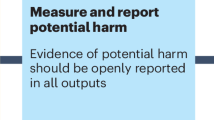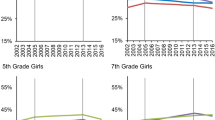Abstract
HEALTHY was a 3-year middle school-based primary prevention trial to reduce modifiable risk factors for type 2 diabetes in youth. The study was conducted at seven centers across the country. This paper describes the recruitment and retention activities employed in the study. Schools and students were the focus of recruitment and retention. Each center was responsible for the recruitment of six schools; eligibility was based on ability to enroll a sufficient number of predominately minority and lower socioeconomic status students. Study staff met with district superintendents and school principals to verify the eligibility of schools, and to ascertain how appropriate the school would be for conducting the trial. Sixth grade students were recruited employing a variety of techniques; students and their parents did not know whether their school was randomized to the intervention or control arm. This cohort was followed through sixth, seventh and eighth grades. In the eighth grade, an additional sample of students who were not originally enrolled in the study was recruited in a similar manner to participate in data collection to allow for cross-sectional and dose-response secondary analyses. Parents signed informed consent forms and children signed informed assent forms, as per the needs of the local Institutional Review Board. Parents received a letter describing the results of the health screening for their children after data collection in sixth and eighth grades. Retention of schools and students was critical for the success of the study and was encouraged through the use of financial incentives and other strategies. To a large extent, student withdrawal due to out-migration (transfer and geographical relocation) was beyond the ability of the study to control. A multi-level approach that proactively addressed school and parent concerns was crucial for the success of recruitment and retention in the HEALTHY study.
This is a preview of subscription content, access via your institution
Access options
Subscribe to this journal
Receive 12 print issues and online access
$259.00 per year
only $21.58 per issue
Buy this article
- Purchase on Springer Link
- Instant access to full article PDF
Prices may be subject to local taxes which are calculated during checkout
Similar content being viewed by others
References
The HEALTHY Study Group. HEALTHY study rationale, design and methods: moderating risk of type 2 diabetes in multi-ethnic middle school students. Int J Obes 2009; 33 (Suppl 4): S4–S20.
Shavers VL, Lynch CF, Burmeister LF . Racial differences in factors that influence the willingness to participate in medical research studies. Ann Epidemiol 2002; 12: 248–256.
Harrell JS, Bradley C, Dennis J, Frauman AC, Criswell ES . School-based research: problems of access and consent. J Pediatr Nurs 2000; 15: 14–21.
Olds RS, Symons CW . Recommendations for obtaining cooperation to conduct school-based research. J Sch Health 1990; 60: 96–98.
Petosa R, Goodman RM . Recruitment and retention of schools participating in school health research. J Sch Health 1991; 61: 426–429.
Post A, Galanti MR, Gilliam H . School and family participation in a longitudinal study of tobacco use: some methodological notes. Eur J Public Health 2003; 13: 75–76.
Croft JB, Webber LS, Parker FC, Berenson GS . Recruitment and participation of children in a long-term study of cardiovascular disease: the Bogalusa Heart Study, 1973–1982. Am J Epidemiol 1984; 120: 436–448.
Harrington KF, Binkley D, Reynolds KD, Duvall RC, Copeland JR, Franklin F et al. Recruitment issues in school-based research: lessons learned from the High 5 Alabama Project. J Sch Health 1997; 67: 415–421.
Sexton K, Adgate JL, Church TR, Greaves IA, Ramachandran G, Fredrickson AL et al. Recruitment, retention, and compliance results from a probability study of children's environmental health in economically disadvantaged neighborhoods. Environ Health Perspect 2003; 111: 731–736.
Sexton K . Comparison of recruitment, retention, and compliance results for three children's exposure monitoring studies. J Expo Anal Environ Epidemiol 2005; 15: 350–356.
Elder JP, Shuler L, Moe SG, Grieser M, Pratt C, Cameron S et al. Recruiting a diverse group of middle school girls into the trial of activity for adolescent girls. J Sch Health 2008; 78: 523–531.
Belzer Jr EG, McIntyre L, Simpson C, Officer S, Stadey N . A method to increase informed consent in school health research. J Sch Health 1993; 63: 316–317.
Frye FH, Baxter SD, Thompson WO, Guinn CH . Influence of school, class, ethnicity, and gender on agreement of fourth graders to participate in a nutrition study. J Sch Health 2002; 72: 115–120.
Frye FH, Baxter SD, Litaker MS, Thompson WO, Guinn CH, Baglio ML et al. Differences in fourth-graders’ participation rates across four school-based nutrition studies. J Child Nutr Manag 2003; 27: http://docs.schoolnutrition.org/newsroom/jcnm/03fall/frye/.
Raynor HA, Osterholt KM, Hart CN, Jelalian E, Vivier P, Wing RR . Evaluation of active and passive recruitment methods used in randomized controlled trials targeting pediatric obesity. Int J Pediatr Obes 2008; 11: 1–9.
Fitzgibbon ML, Prewitt TE, Blackman LR, Simon P, Luke A, Keys LC et al. Quantitative assessment of recruitment efforts for prevention trials in two diverse black populations. Prev Med 1998; 27: 838–845.
Liese AD, Liu L, Davis C, Standiford D, Waitzfelder B, Dabelea D et al. Participation in pediatric epidemiologic research: the SEARCH for Diabetes in Youth Study experience. Contemp Clin Trials 2008; 29: 829–836.
Pound B, Riddell M, Byrnes G, Kelly H . Perception of social value predicts participation in school-based research. Aust N Z J Public Health 2000; 24: 543–545.
Good M, Schuler L . Subject retention in a controlled clinical trial. J Adv Nurs 1997; 26: 351–355.
Jones FC, Broome ME . Focus groups with African American adolescents: enhancing recruitment and retention in intervention studies. J Pediatr Nurs 2001; 16: 88–96.
STOPP-T2D Prevention Study Group. Presence of diabetes risk factors in a large US eighth-grade cohort. Diabetes Care 2006; 29: 212–217.
Acknowledgements
We thank the past and present investigators on the Recruitment & Retention Committee who were Joanne Harrell (chair), Lisa Bouchard, Barbara Curlee, Mackenzie Dobbins, Kimberly Drews, Debby Ford, Linn Goldberg, Katie Hindes, Ann Jessup, Francine Kaufman, Barbara Linder, Sara Mazzuto, Joan Nachmani, Jean-Baptiste Roullet, Debbe Thompson, Alissa Wheeler, Tara Wilson and Zenong Yin. We certify that all applicable institutional and governmental regulations concerning the ethical use of human volunteers were followed during this research.
Author information
Authors and Affiliations
Consortia
Corresponding author
Rights and permissions
About this article
Cite this article
Drews, K., Harrell, J., Thompson, D. et al. Recruitment and retention strategies and methods in the HEALTHY study. Int J Obes 33 (Suppl 4), S21–S28 (2009). https://doi.org/10.1038/ijo.2009.113
Published:
Issue Date:
DOI: https://doi.org/10.1038/ijo.2009.113
Keywords
This article is cited by
-
A cluster randomised controlled trial to assess the effectiveness of a multi-strategy sustainability intervention on teachers’ sustained implementation of classroom physical activity breaks (energisers): study protocol
BMC Public Health (2023)
-
Feasibility of an incentive scheme to promote active travel to school: a pilot cluster randomised trial
Pilot and Feasibility Studies (2017)
-
Recruitment and Retention of Children in Behavioral Health Risk Factor Studies: REACH Strategies
International Journal of Behavioral Medicine (2014)
-
Lessons Learned From the HEALTHY Primary Prevention Trial of Risk Factors for Type 2 Diabetes in Middle School Youth
Current Diabetes Reports (2013)
-
Student public commitment in a school-based diabetes prevention project: impact on physical health and health behavior
BMC Public Health (2011)



